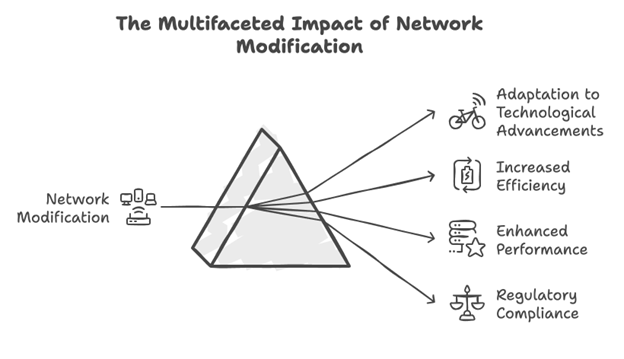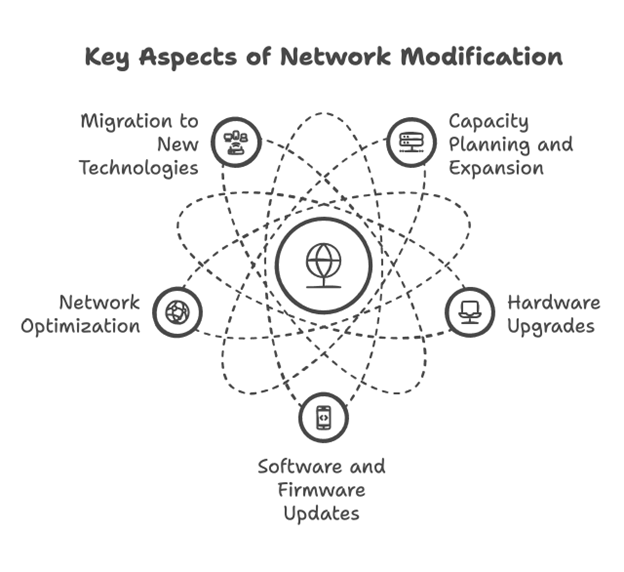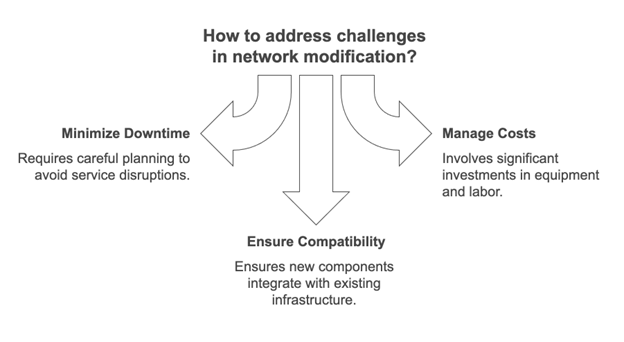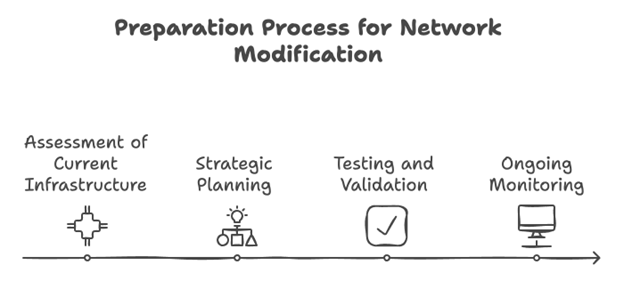Network Modification: Transforming Telecom Networks for the Future
The ever-evolving landscape of telecommunications demands continual enhancements and adjustments to ensure efficiency, scalability, and performance. Network modification plays a crucial role in meeting these demands. By upgrading, reconfiguring, and optimizing telecom networks, businesses can stay ahead of technological advancements and market demands while minimizing downtime and costs.
Network modification refers to the strategic changes implemented to improve or expand an existing telecommunications network. These changes may include hardware upgrades, software updates, capacity enhancements, or structural reconfigurations. Whether addressing outdated equipment, integrating new technologies, or adapting to increased user demand, network modification is essential to maintaining a robust and reliable telecom infrastructure.
Why Network Modification Matters
As telecom networks grow more complex, the need for modification becomes increasingly vital. Key reasons to prioritize network modification include:
- Adaptation to Technological Advancements: Innovations such as 5G, IoT, and edge computing require networks to evolve continually.
- Increased Efficiency: Optimizing existing infrastructure through network modification can significantly reduce operational costs and energy consumption.
- Enhanced Performance: Modifications ensure that networks can handle higher traffic volumes and provide consistent, high-speed connectivity.
- Regulatory Compliance: Adjustments often help telecom operators meet changing industry standards and government regulations.

Key Areas of Network Modification
Network modification encompasses several critical areas that are essential for maintaining and enhancing the performance of telecom infrastructure. Each area addresses specific challenges and opportunities within the network ecosystem, ensuring that the system is prepared for both current demands and future advancements. By focusing on these key areas, telecom providers can strategically enhance their networks to achieve optimal efficiency, reliability, and scalability.
Network modification spans several critical areas, each contributing to the seamless operation of telecom infrastructure. Below are the most pivotal aspects:

1. Capacity Planning and Expansion
As user demand for bandwidth grows, networks must scale to accommodate this increase. Capacity planning involves evaluating current usage patterns and forecasting future needs to implement modifications that ensure uninterrupted service.
2. Hardware Upgrades
Outdated equipment can hinder network performance and reliability. Replacing legacy systems with modern hardware enhances network capabilities, improves energy efficiency, and supports the integration of advanced technologies.
3. Software and Firmware Updates
Keeping software and firmware up to date is a critical aspect of network modification. Regular updates address security vulnerabilities, improve functionality, and enable compatibility with new devices and services.
4. Network Optimization
Optimization focuses on improving overall performance by reconfiguring network architecture, reallocating resources, and eliminating bottlenecks. This aspect of network modification ensures seamless connectivity and maximized throughput.
5. Migration to New Technologies
Telecom providers often modify networks to transition from older technologies to newer, more efficient ones. For example, migrating from 4G to 5G infrastructure is a common form of network modification that enhances speed and reduces latency.
Benefits of Network Modification
Strategic network modifications offer numerous advantages for telecom providers and their customers. These include:
- Improved User Experience: Enhanced performance and reliability translate to better service quality for end-users.
- Cost Savings: Proactively addressing issues and upgrading infrastructure can prevent costly downtime and emergency repairs.
- Future-Proofing: Modifications help networks adapt to emerging trends and technologies, ensuring long-term viability.
- Enhanced Security: Updating systems and addressing vulnerabilities strengthens network defenses against cyber threats.
Challenges in Network Modification
While network modification offers numerous benefits, it also presents several challenges that must be carefully navigated to ensure success. These challenges often stem from the complexity of modern telecom systems and the need to balance technical requirements with operational realities. Understanding these hurdles is crucial for devising effective strategies and minimizing potential risks.
While the benefits are clear, network modification is not without challenges. These may include:
- Minimizing Downtime: Implementing changes without disrupting service requires careful planning and execution.
- Cost Management: Network modifications often involve significant investments in equipment and labor.
- Compatibility Issues: Ensuring new network components integrate seamlessly with existing infrastructure is essential to avoid performance issues.


Preparing for Network Modification
Preparation is the cornerstone of successful network modification. Given the intricate nature of telecom networks, any modification requires a well-thought-out strategy to ensure effectiveness and minimize disruptions. By thoroughly assessing the current infrastructure and aligning modifications with organizational goals, telecom providers can lay the groundwork for seamless execution and long-term benefits.
Successful network modification requires a comprehensive approach, including:
- Assessment of Current Infrastructure: A detailed evaluation identifies weaknesses and areas for improvement.
- Strategic Planning: Defining clear objectives and developing a roadmap ensures modifications align with organizational goals.
- Testing and Validation: Rigorous testing minimizes the risk of errors during implementation.
- Ongoing Monitoring: Continuous monitoring post-modification ensures the network performs as intended and adapts to future needs.
How Network Modification Supports Telecom Growth
In a competitive industry, staying ahead of technological and market trends is paramount. Network modification allows telecom companies to:
- Expand coverage to underserved areas.
- Support high-demand applications such as video streaming and cloud services.
- Improve network reliability and minimize disruptions.
By investing in network modification, telecom providers not only enhance their infrastructure but also position themselves as leaders in innovation and service quality.
The Strategic Importance of Network Modification
Network modification is the backbone of a resilient and future-ready telecommunications network. By embracing changes and implementing strategic enhancements, telecom providers can ensure their networks meet the demands of today and tomorrow. Detailed insights into specific aspects of network modification, such as capacity expansion, hardware upgrades, and network optimization, will be covered in dedicated pages within this silo. With a strong focus on continuous improvement, network modification will remain an integral part of telecom success in the years to come.
DataField is a leading provider in the telecommunications industry. Not only do we specialize in fiber optic network planning and design, but we can also help you update and future-proof your existing network through our strategic network modification services and practices.
Call DataField today at 614-847-9600 for a consultation with a network modification expert.
Frequently Asked Questions about Network Modification
Network modification refers to strategic changes made to existing telecommunications networks to improve performance, scalability, and efficiency. This can involve hardware upgrades, software updates, network optimization, or migrating to new technologies like 5G.
Network modification ensures that telecom infrastructure remains reliable, secure, and capable of meeting growing demands. It helps adapt to technological advancements, enhance performance, and comply with industry regulations.
The duration of a network modification project depends on its scope and complexity. Smaller updates like software upgrades can take a few hours or days, while larger projects like hardware overhauls or technology migrations may take weeks or months.
Service disruptions are minimized through careful planning and phased implementation. Most modifications are conducted during off-peak hours to reduce the impact on users.
Network modification costs vary depending on the type and scale of modification. Factors include equipment costs, labor, software licensing, and potential downtime expenses. A thorough cost analysis is typically conducted during the planning phase.
Common challenges include minimizing service downtime, managing costs, and ensuring compatibility between new and existing network components. These challenges are addressed through strategic planning and rigorous testing.
Technologies such as 5G infrastructure, IoT integration, cloud computing, and software-defined networking (SDN) often play a role in modern network modification projects.
Indicators include performance bottlenecks, outdated equipment, increasing user demands, and the need to adopt new technologies. A professional network assessment can identify specific areas for improvement.
Network modifications are typically carried out by telecom engineers, IT specialists, or third-party service providers with expertise in network architecture and management.
Preparation involves assessing current infrastructure, defining goals, creating a detailed plan, and setting aside a budget. Engaging experienced professionals ensures a smooth process.
Neglecting network modifications can lead to reduced performance, security vulnerabilities, increased operational costs, and an inability to support modern applications or user demands.
Benefits include improved user satisfaction, reduced operational costs, enhanced security, and the ability to scale operations. It also positions your organization to adapt to future technology trends.
If you have more questions about network modification or need professional advice, feel free to reach out to our experts!

